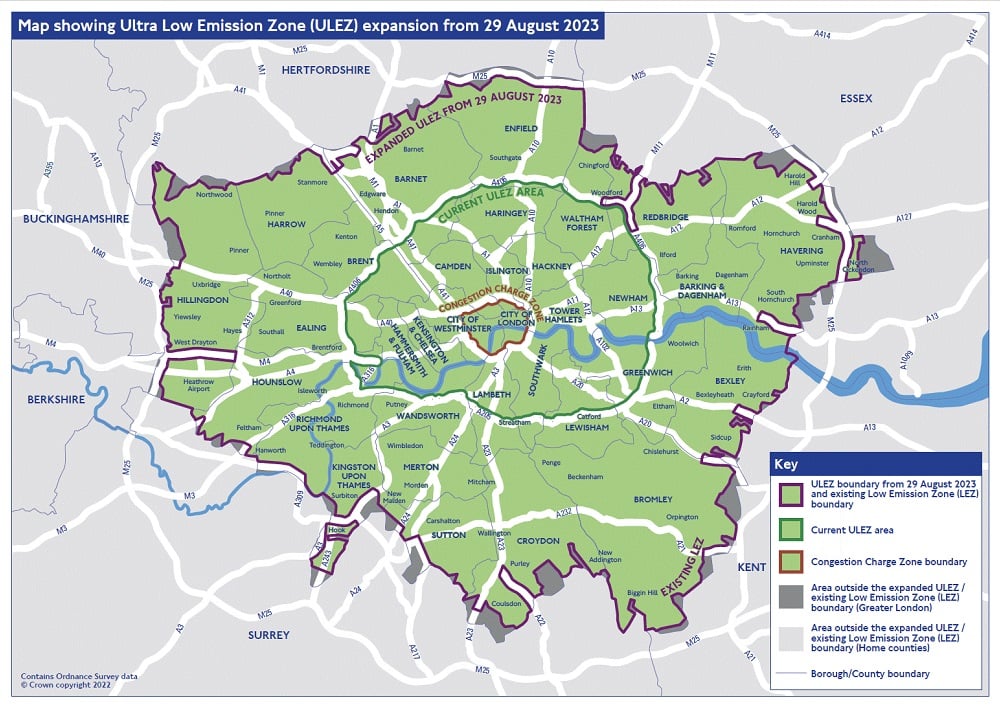If you’re a commercial fleet manager, then this important. On one hand, there’s a whole new raft of compliance and charges to get your head around and factor into operating costs. On the other, the expansion of the ULEZ boroughs in London has connotations for all fleets, regardless of whether you operate in that area or not, as councils around the country will introduce similar zones in the not-too-distant future.
What’s the current situation?
With London’s Ultra-Low Emissions Zone (ULEZ) now expanded across all 32 boroughs, commercial drivers who are non-compliant with their carbon emissions will be charged every day they enter a zone.
There’s not many fully ULEV fleets out there on the streets and realistically there’s no real way to navigate around the zones without putting some serious miles on the clock, so this is a case of fleets needing to start factoring additional costs into their budgets.
But given London’s economy relies so heavily on the services of fleet operators the initial costs are limited to £12.50 per vehicle per day. However, there are some sub-clauses to the ULEZ expansion for consideration: Lorries, vans or specialist heavy vehicles (all over 3.5 tonnes) and buses, minibuses and coaches (all over 5 tonnes) will instead need to pay the elevated LEZ charge if they do not meet the Low Emission Zone (LEZ) emissions standard as a minimum.
The LEZ charge is £100 for vans that don’t meet the Euro 3 standards, and up to £300 per day for HGVs that don’t meet the Euro 5 standards. Those standards are for pretty old vehicles – Euro 3 is the standard for vehicles produced after 2001, and Euro 5 is for vehicles produced after 2009. So, unless you’re running a very old fleet or vehicle, you’re going to be hit with £12.50 per vehicle for every time you enter a ULEZ zone.
This leaves operators with a couple of key considerations: compliance management, and ULEV transition. And technology is going to be your best friend for navigating both.
Compliance Management
A fleet of ten vehicles entering ULEZ zones every day is an extra £125 per day, multiplied by 260 working days in the 2023 calendar year, and you get an extra £3,250 of costs.
But that’s a lot of charges to keep on top of. So, keeping those additional costs capped means an efficient process to track and pay those charges.
Fleet management software can help you simplify fleet compliance. With the latest fleet management software and a wide range of flexible apps you can digitise and streamline the processes that underpin compliance management, particularly Road User Charges.
These fleet management integrations can log and display road user charges in real-time, using high-definition GPS data. Fleet Managers can then run quick reports to easily see who’s accessed which zones and when and make accurate payments via the official channels and within the allotted deadlines.
ULEV Transition
The ULEZ boroughs are here to stay as we target a reduced carbon future, and some cities and councils across the country have already started to mobilise their own versions – more will follow quickly. This is a situation that fleet operators need to consider carefully – additional costs in the short term, or larger costs in the short term to transition to ULEVs and bring the costs down in the long term.
While some companies are escalating the rollout of electric and alternative fuel vehicles across their fleets, there are many businesses not as confident to make the move due to lack of data they have available, as well as a lack of guidance on how to do it properly or when the best time for their fleet might be.
What makes it even trickier is that it’s not a one-size-fits-all solution, as different fleets will require different considerations. It’s not realistic to expect operators to overhaul their entire fleet at the touch of a button. This is where technology can play a vital role in making the conversion in the most cost-effective way.
Using the up-to-date analytics of your current fleet state there is software available to operators that can predict which vehicles in a fleet will be ready to convert from petrol or diesel, to electric and when. By using smart algorithms to assess trip data, the tool provides fleet operators with insight into the feasibility of switching to EV, amongst other elements including suitable vehicles in-market, total cost of ownership, fuel savings and environmental impact. It examines whether a fleet is viable for switching and rather than providing a blanket yes or no, the customisable platform can offer a forensic analysis of vehicle use-data to provide a phased approach to transitioning to an EV fleet.
As well as having a huge positive impact on emissions and a company’s eco commitments, switching to EV can also save companies additional charges, such as ULEZ.
This is very much going to be a mixed-fleet future for many years to come, where fleet operators utilise both ICE and ultra-low emission vehicles, which is a realistic solution given how the market is progressing with vehicle availability, range, infrastructure, and accessible price points.
But there is help in the short term to ensure compliance doesn’t become a headache and help for the long-term as we embark on this exciting new low emission future.
Author: Barney Goffer, UK Product Manager at Teletrac Navman UK








